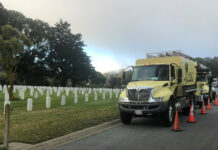Late summer is a good time to look for potential problems in your customers’ landscapes. Early leaf color changes or drop, galls on external tree tissues, and caterpillar webs are three of the possible things that may be affecting your customers’ trees and shrubs. But before you start up the chainsaw and chipper in despair, recognize that not all stress symptoms are a death sentence for the plant.

Early Leaf Color Changes. We look forward to a good fall foliage color display in October and November, but what if those colors appear early—in August or September? Premature color change can be an indication that a tree is lacking the vigor to withstand insects and disease organisms that may attack it—or there could be environmental imbalances as well.
Heat, drought, and drying winds affect trees, causing leaf color changes as a response to stress. Are there only one or two branches affected? This could be a sign of a disease at work, especially if the affected leaves also have dark spots or are discolored. The more common situation is for the entire tree to exhibit premature fall coloration, a phenomenon usually linked to root-related stress. And to complicate the diagnostic process further, there are several tree species genetically programmed to go dormant during hot summer months and drop browning, curled leaves in response to heat stress.

The best way to counter early leaf stress symptoms is to know which tree species you are working with. Are those curled, brown leaves on a hackberry that normally goes dormant in the summer? Or are they on a dogwood that just needs a good soaking of water to revive its flagging leaves? Knowing the tree species will help you to provide the specific care they need year-round.
Galls. Another visible tree/plant symptom that might cause concern are galls. These are abnormal, raised growths usually caused by insects and mites, and can appear on leaves, twigs, or branches of trees and shrubs (see inset photo above). These plant structures may be plain brown or brightly colored, and can become more apparent as they age throughout the summer. Depending on the insect inhabiting them, the galls may be empty by the time August arrives—or adult insects may just be emerging in late summer. These adults and the galls themselves are usually harmless, so no active management is required.
Caterpillar Tents. Another late summer tree pest is the fall webworm (Hyphantria cunea). This pest is a moth in its adult stage but is primarily known for its larval stage, which creates the characteristic webbed nests on the limbs of a wide variety of host trees such as cherry, willow, and American elm. These tents may defoliate a tree occasionally, but rarely kill it. On shade trees, webs usually occur on only a few branches. While the tents are aesthetically startling, this pest is not believed to harm healthy trees. The fall webworm has natural enemies, including birds and insect predators, that help to manage its numbers. Mechanical controls may provide an immediate visual relief, if desired. Webbed branches within reach can be pruned and destroyed. This may be practical if the webs are not too large, and if the aesthetic shape of the woody ornamental plant is not reduced by pruning.
There are management controls, such as dormant oil, that can be applied to newly hatched webworm eggs in the spring. (From Wikipedia: Dormant oil is used on woody plants during the dormant season. This term originally referred to heavier weight, less well-refined oils that were unsafe to use on plants after they broke dormancy. These older oils have been replaced with more refined, lightweight oils that have potential application to plant foliage. Dormant oil now refers to time of application rather than to any characteristic type of oil.)
Healthy trees are quite resilient to late summer stresses. Add regular irrigation to your management protocols and your customers’ trees will be able to defend themselves well into the fall.
Andersen is a Board Certified Master Arborist, Certified Treecare Safety Professional, and the staff arborist at the TreeCare Industry Association, a Manchester, NH-based trade association of 2,300 tree care firms and affiliated companies established in 1938 as the National Arborist Association.
Do you have a comment? Share your thoughts in the Comments section below or send an e-mail to the Editor at acosgrove@groupc.com.











![[VIDEO] Dickies®: Discover Workwear That’s Anything But Uniform](https://turfmagazine.com/wp-content/uploads/2023/06/1647663814-4b1a2a7742790a9b1e97a3b963477850192e1d6a9dfba9b07214a77bae25d6e3-d-218x150.jpg)






























![[VIDEO] Dickies®: Discover Workwear That’s Anything But Uniform](https://turfmagazine.com/wp-content/uploads/2023/06/1647663814-4b1a2a7742790a9b1e97a3b963477850192e1d6a9dfba9b07214a77bae25d6e3-d-324x160.jpg)